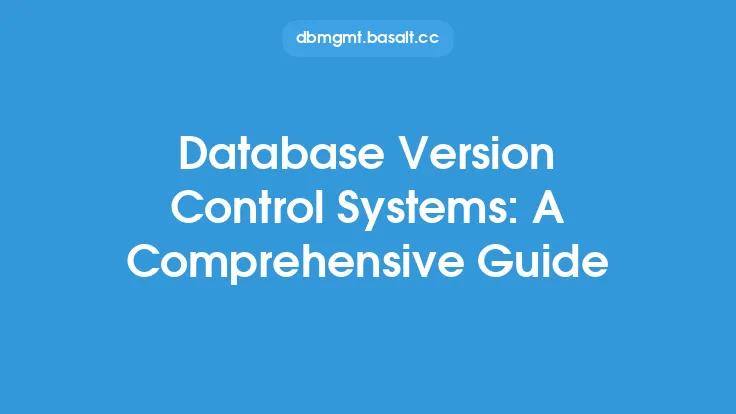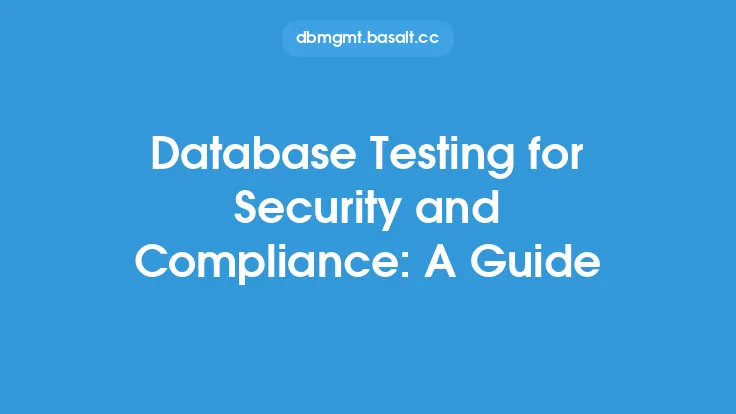Access control is a critical component of database security, as it ensures that only authorized individuals or systems can access, modify, or delete sensitive data. In today's digital age, databases are the backbone of most organizations, storing valuable information such as customer data, financial records, and intellectual property. As such, it is essential to implement robust access control measures to protect against unauthorized access, data breaches, and other security threats.
Introduction to Access Control
Access control is a set of mechanisms and policies that regulate who can access a database, what actions they can perform, and under what circumstances. It involves identifying and authenticating users, assigning permissions and privileges, and monitoring their activities to prevent unauthorized access or malicious behavior. Effective access control is essential to prevent data breaches, ensure compliance with regulatory requirements, and maintain the integrity and confidentiality of sensitive data.
Types of Access Control
There are several types of access control, including:
- Discretionary Access Control (DAC): This type of access control grants or denies access to a database based on the discretion of the owner or administrator. DAC is often used in environments where access control is not strictly regulated.
- Mandatory Access Control (MAC): This type of access control enforces a set of rules that regulate access to a database based on the sensitivity level of the data and the clearance level of the user. MAC is often used in environments where access control is strictly regulated, such as in government or military organizations.
- Role-Based Access Control (RBAC): This type of access control grants access to a database based on the role or function of the user within an organization. RBAC is often used in environments where access control needs to be flexible and scalable.
Access Control Mechanisms
Access control mechanisms are the technical components that enforce access control policies. These mechanisms include:
- Authentication: This mechanism verifies the identity of a user or system before granting access to a database. Common authentication methods include username and password, biometric authentication, and smart cards.
- Authorization: This mechanism determines what actions a user or system can perform on a database once they have been authenticated. Authorization is often based on the user's role, privileges, or permissions.
- Encryption: This mechanism protects data in transit or at rest by converting it into an unreadable format. Encryption is often used to protect sensitive data, such as financial information or personal identifiable information.
- Access Control Lists (ACLs): This mechanism grants or denies access to a database based on a set of rules that define what actions a user or system can perform. ACLs are often used in conjunction with authentication and authorization mechanisms.
Database Access Control
Database access control refers to the mechanisms and policies that regulate access to a database management system (DBMS). Database access control involves:
- Database authentication: This mechanism verifies the identity of a user or system before granting access to a DBMS.
- Database authorization: This mechanism determines what actions a user or system can perform on a DBMS once they have been authenticated.
- Database encryption: This mechanism protects data in a DBMS by converting it into an unreadable format.
- Database auditing: This mechanism monitors and logs all activities on a DBMS to detect and respond to security incidents.
Implementing Access Control
Implementing access control requires a comprehensive approach that involves:
- Conducting a risk assessment: This involves identifying potential security threats and vulnerabilities in a database or DBMS.
- Developing an access control policy: This involves defining the rules and procedures for accessing a database or DBMS.
- Implementing access control mechanisms: This involves configuring and deploying access control mechanisms, such as authentication, authorization, and encryption.
- Monitoring and auditing access control: This involves regularly monitoring and auditing access control mechanisms to detect and respond to security incidents.
Best Practices for Access Control
Best practices for access control include:
- Least privilege principle: This principle involves granting users or systems only the privileges and permissions necessary to perform their tasks.
- Separation of duties: This principle involves dividing tasks and responsibilities among multiple users or systems to prevent a single point of failure.
- Regular security audits: This involves regularly monitoring and auditing access control mechanisms to detect and respond to security incidents.
- Continuous training and awareness: This involves providing regular training and awareness programs to users and administrators on access control policies and procedures.
Common Access Control Challenges
Common access control challenges include:
- Complexity: Access control can be complex to implement and manage, especially in large and distributed environments.
- Scalability: Access control mechanisms must be scalable to accommodate growing user populations and increasing data volumes.
- Flexibility: Access control mechanisms must be flexible to accommodate changing business requirements and user needs.
- Compliance: Access control mechanisms must comply with regulatory requirements and industry standards, such as GDPR, HIPAA, and PCI-DSS.
Future of Access Control
The future of access control will involve the use of emerging technologies, such as:
- Artificial intelligence (AI): AI can be used to improve access control by detecting and responding to security incidents in real-time.
- Machine learning (ML): ML can be used to improve access control by analyzing user behavior and detecting anomalies.
- Internet of Things (IoT): IoT devices will require new access control mechanisms to regulate access to sensitive data and prevent security breaches.
- Cloud computing: Cloud computing will require new access control mechanisms to regulate access to cloud-based resources and prevent security breaches.
Conclusion
Access control is a critical component of database security that ensures the confidentiality, integrity, and availability of sensitive data. Effective access control involves implementing robust mechanisms and policies that regulate who can access a database, what actions they can perform, and under what circumstances. By following best practices and staying up-to-date with emerging technologies, organizations can ensure the security and integrity of their databases and protect against unauthorized access, data breaches, and other security threats.





